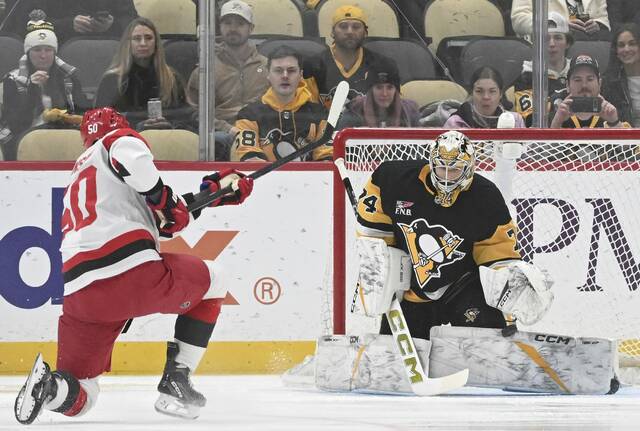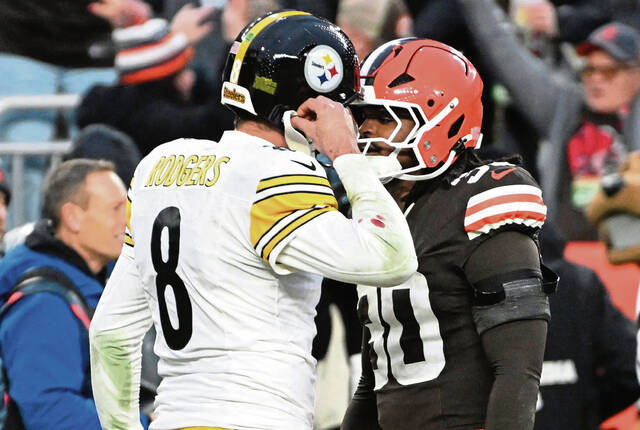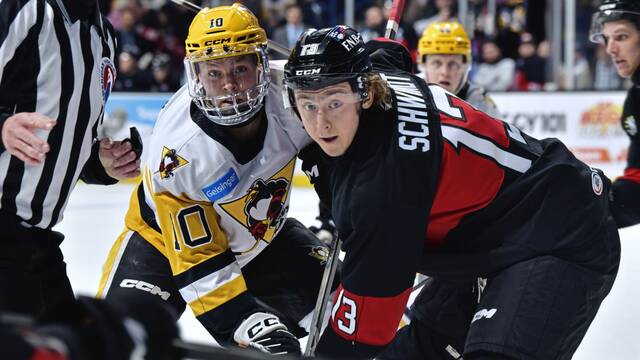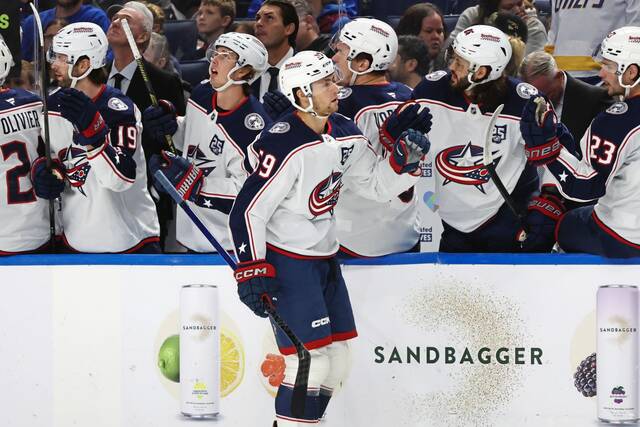While the NHL is on hold because of the ongoing coronavirus pandemic, the Tribune-Review will offer the Double Team project, an examination of the five best players who have contributed substantially to the Penguins and another franchise. For consideration, a player must have played at least the equivalent of a full season for each franchise. (Sorry, Jarome Iginla fans.)
Today, a look at the Toronto Maple Leafs. Founded in 1917, the Maple Leafs are the NHL’s second-oldest franchise. Originally known as the Arenas, the team name was changed to St. Patricks in 1919 then Maple Leafs in 1927, in recognition of Canada’s national symbol.
In 188 all-time games against the Maple Leafs, the Penguins have an 87-77-24 record.
1. Phil Kessel, right winger
When he acquired Kessel in a trade from the Maple Leafs during the 2015 offseason, Penguins general manager Jim Rutherford was asked what concerns he had about Kessel’s character. After all, things got very toxic for the introverted Kessel in Toronto.
“He was always ‘the guy’ (in Toronto),” Rutherford said. “He was the guy that was blamed when things weren’t going well. And he doesn’t have to be ‘the guy’ here. We have a bunch of them. So I believe he’s going to fit in very well.”
In his own, odd idiosyncratic way, Kessel was a marvelous fit with the Penguins.
Initially acquired to be a right winger with franchise center Sidney Crosby, Kessel, who had 26 goals and 59 points in 82 games during his first regular season with the Penguins, eventually helped form the dangerous HBK Line with center Nick Bonino and left winger Carl Hagelin by the time the postseason opened. In the playoffs, Kessel was dominant, leading the team with 22 points in 24 games and, of course, became a Stanley Cup champion.
Putting up 70 points in 82 games the following regular season, Kessel and the Penguins were Stanley Cup champions again, thanks to Kessel chipping in 23 points in 25 postseason games.
Kessel spent two more seasons with the Penguins and set a career-best with 92 points in 82 games during the 2016-17 campaign but had two lackluster playoff efforts.
In June 2019, the Penguins dealt Kessel to the Arizona Coyotes.
A decade earlier, the Maple Leafs hoped Kessel would the centerpiece of a new era of dominance. General manager Brian Burke acquired Kessel from the Boston Bruins in September 2009 with designs of building a Stanley Cup contender around him.
By most measures, Kessel delivered on the ice, reaching the 30-goal mark in four of his six seasons with the Maple Leafs and was a three-time All-Star during that span.
But the Maple Leafs reached the playoffs only once during Kessel’s tenure in Toronto. That futility along with Kessel’s reluctance to truly embrace being the face of a franchise in the self-proclaimed “hockey capital of the universe” led to things turning sour for all involved.
With new management ready to embark on yet another rebuilding project, the Maple Leafs retained some of Kessel’s salary in order to trade him to the Penguins.
2. Rick Kehoe, right winger
A native of Windsor, Ont., Kehoe realized a dream of many in his province by being selected in the second round of the 1971 draft by the Maple Leafs.
After debuting in 1971-72 with 38 games and 16 assists, Kehoe broke out in 1972-73 by finishing second on the Maple Leafs with 75 points, including 33 goals, in 77 games.
But by the following season, he saw his playing time dwindle in favor of rookie forwards Lanny MacDonald and Inge Hammarstrom and saw his offense dip to 40 points in 69 games.
Openly dissatisfied with the situation, Kehoe was traded to the Penguins in September 1974. A member of the Penguins for 11 seasons, Kehoe became the franchise’s most prolific scorer before the arrival of Mario Lemieux in the mid-1980s.
Starting with a 30-goal effort in 1974-75, Kehoe reached the 20-goal mark in his first nine seasons in Pittsburgh. His signature season of 1980-81 saw him set a then-franchise record of 55 goals as well as 88 points in 1980-81. Additionally, he became the first player in franchise history to win the Lady Byng Memorial Trophy, which recognizes gentlemanly play.
A two-time All-Star with the Penguins, Kehoe’s career came to an end in October 1984 because of a neck injury. Afterward, he held a variety of positions with the organization including scout, assistant coach and head coach until the mid-2000s.
3. Eddie Shack, left winger
As a key member of the last Maple Leafs teams to win the Stanley Cup in the 1960s, Shack was a wildly popular figure in Toronto not only for his on-ice success but also for his showmanship.
Known as “The Entertainer,” Shack would stand on the bench, waving his arms to encourage the “We Want Shack!” chants Toronto fans would rain down on the ice of Maple Leaf Gardens. On the occasions he would be named one of the game’s three stars, Shack would do a pirouette at center ice. Shack was so beloved, a song titled “Clear The Track, Here Comes Shack” topped the music charts in Canada.
Lost in the attention directed toward his antics was the fact he was a pretty good player. Acquired in a trade with the New York Rangers in February 1960, Shack, one of the tougher players of his era, spent nine seasons with the Maple Leafs and was selected for three All-Star Games.
More importantly, Shack was a member of four Stanley Cup championship teams in 1962, ‘63, ‘64 and ‘67. He scored the Stanley Cup-clinching goal in a 3-1 home win against the Detroit Red Wings in Game 5 of the 1963 Final. Shack joked he actually was trying to get out of the way of a shot but had the puck go off his backside and into the net.
Traded to the Bruins in the 1967 offseason, Shack also spent time with the Los Angeles Kings and Buffalo Sabres before being traded to the Penguins in March 1972. Putting up 14 points in 13 games after the transaction, Shack helped the Penguins reach the playoffs for the second time in franchise history.
His sole complete season with the Penguins was in 1972-73. Teamed with Ken Schinkel and Ron Schock on the phonetically pleasing Schink-Schock-Shack Line, Shack, at the age of 35, became the first player in NHL history to reach the 20-goal barrier for five teams by putting up 25 goals and 45 points in 74 games.
During the 1973 offseason, Shack was traded back to the Maple Leafs and spent the final two seasons of his career as a role player in Toronto.
4. Dave Burrows, defenseman
To illustrate how good a defensive player Burrows was, consider the context of the era he played in. Throughout the post-expansion 1970s when the likes of defensemen such as Bobby Orr and Denis Potvin were reaching the 100-point barrier, Burrows never did better than 29 points in a season but was selected for three All-Star Games during his 10-year NHL career.
The Penguins claimed him in the 1971 intra-league draft from the Chicago Black Hawks and teamed him with future Hockey Hall of Fame defenseman Tim Horton in 1971-72. Under that apprenticeship, Burrows appeared in 77 games and recorded 12 points. His defense stood out so much, he finished fourth in voting for the Calder Memorial Trophy, which recognizes the league’s top rookie.
A fearless shot blocker who could throw a stiff hip check, Burrows’ best season was in 1975-76 when he netted 29 points in 80 games and finished 10th in voting for the Hart Memorial Trophy, the league’s MVP award.
A two-time All-Star with the Penguins, Burrows was traded to his hometown Maple Leafs in the 1978 offseason. Spending parts of three seasons in Toronto, Burrows helped the Maple Leafs reach the postseason twice and was selected for the All-Star Game again in 1980.
By November 1980, Burrow was dealt back to the Penguins. By that point of his career, Burrows’ body was worn down and he retired after the 1980-81 campaign.
5. George Ferguson, center
A first-round pick in 1972, the “Fergie Flyer,” spent the first six seasons of his NHL career with the Maple Leafs.
Ferguson was mainly a role player during his six seasons with the Maple Leafs, helping them reach the postseason five times.
While he was a popular player in Toronto, Ferguson never truly lived up to his potential with the Maple Leafs. His high-water mark with the franchise was 49 points in 69 games during the 1974-75 campaign.
After a trade in June 1978, Ferguson’s career took off with the Penguins. In 1978-79, he broke out with 21 goals and 50 points in 80 games. His most notable moment with the Penguins came during Game 3 of a preliminary round series against the Sabres when he scored the series-clinching goal in a 4-3 road win.
Ferguson, who was also a strong penalty killer and led the Penguins in short-handed goals in four seasons, reached the 20-goal mark in four of his five seasons with the Penguins before being traded to the Minnesota North Stars in October 1982.
Honorable mention: Leo Boivin, defenseman; Pat Boutette, center; Larry Murphy, defenseman; Steve Sullivan, right winger; Ken Wregget, goaltender.








